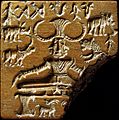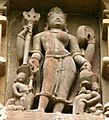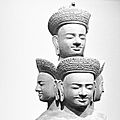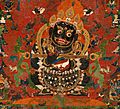Shiva facts for kids
Quick facts for kids Shiva |
|
|---|---|
| Supreme Being; Lord of Divine Energy, Meditation, Arts, Yoga, Time, Destruction, Dance; Supreme Destroyer of Evil; Lord of The Devas (gods); | |
| Member of Trimurti | |
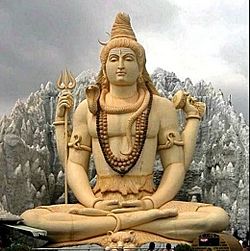
Statue of Shiva in the lotus position at Shivoham Temple
|
|
| Other names | Mahesha, Shankara, Bholenath, Neelkanth, Mahadeva |
| Affiliation | Parabrahman (Shaivism), Trimurti, Paramatmat, Ishvara, Deva |
| Abode | Mount Kailash |
| Mantra | Om Namah Shivaya |
| Weapon | Pashupatastra, Trident, Parashu-Axe, Pinaka bow |
| Symbols | Lingam, Trident, Crescent Moon, Damaru Drum |
| Mount | Nandi (bull) |
| Festivals | Shraavana, Maha Shivaratri, Ekadashi, Kartik Purnima, Bhairava Ashtami |
| Personal information | |
| Consort | Parvati (Adi Parashakti, Sati, Durga, Kali, Mahakali) |
| Children | Ganesha, Kartikeya, Ashokasundari Regional: Ayyappa |
Shiva is one of the most important gods in Hinduism. He is often called the "destroyer god" because he helps remove evil and bring about change in the world. Shiva is part of the Trimurti, which is a group of three main Hindu gods. The other two gods are Brahma, the creator, and Vishnu, the preserver.
Shiva's wife is the goddess Parvati. They have two sons, Ganesha and Kartikeya. Shiva is known for living high up in the Himalayas on Mount Kailash. He is also seen as the special god of yoga, meditation, and the arts.
You can often recognize Shiva by his unique look. He has a blue throat, which comes from a story where he drank poison to save the universe. He also has a third eye on his forehead. Around his neck, he often wears the serpent king Vasuki. A crescent moon sits on his head, and the holy river Ganga flows from his matted hair. His main weapon is a trishula, or trident, and he carries a small drum called a damaru. Many Hindu texts also connect Shiva with an older god named Rudra.
Shaivism: Worshipping Shiva

Shaivism is one of the four main groups of Hinduism. People who follow Shaivism are called "Shaivas." They believe that Shiva is the Supreme Being, meaning he is the highest god.
Shaivas believe Shiva is everything. He is the creator of the universe, the one who keeps it going, and the one who brings about its end. They see him as being in all things and everywhere. For Shaivas, Shiva is the pure spirit and the ultimate truth of the universe.
What Makes Shiva Special?
Shiva has many special features and symbols. These help people understand his powers and what he represents.
Shiva's Third Eye
Shiva is often shown with a third eye on his forehead. This eye is very powerful. It is said that he once used it to burn a god named Kama (Desire) to ashes. This third eye shows Shiva's wisdom and his ability to see beyond what is normal.
The Crescent Moon
A crescent moon rests on Shiva's head. This symbol is very old and shows his connection to the moon. It also links him to Soma, a sacred drink in ancient times, which was also connected to the moon.
Ashes on His Body
Shiva's body is often covered with ashes, called bhasma. These ashes remind us that everything in the world eventually comes to an end and turns to dust. It teaches that focusing on our inner spirit and seeking freedom from worldly things is important.
His Matted Hair
Shiva has long, matted hair. This style is unique to him. It is from his hair that the sacred Ganga river is said to flow down to Earth. This shows his power to control mighty forces of nature.
Why Shiva's Throat is Blue
Shiva has a blue throat, which gives him the name Nīlakaṇtha (meaning "blue throat"). This comes from a famous story called the Samudra Manthana. During this event, a deadly poison called Halahala came out. To save the universe, Shiva drank the poison. His wife, Parvati, quickly squeezed his neck to stop the poison from spreading. The poison stayed in his throat, turning it blue, but saving the world.
Shiva as a Meditating Yogi
Shiva is often shown sitting in a Yoga pose, deep in meditation. He is seen as the "Lord of Yoga." This shows his focus, calm, and control over his mind and body. His home, Mount Kailash, is often shown as his meditation spot.
The Tiger Skin
Shiva is often seated on a tiger skin. The tiger represents power and strength. Sitting on it shows that Shiva has control over these wild forces.
The Serpent Vasuki
The serpent Vasuki is often seen around Shiva's neck like a garland. Vasuki is a king of snakes. According to a story, Vasuki was blessed by Shiva and became his ornament after the great churning of the ocean.
Shiva's Trident (Trishula)
Shiva usually carries a trident called a Trishula. This weapon is also a powerful symbol. It can represent Shiva's three main roles: creator, preserver, and destroyer. It can also stand for the balance of three qualities in nature: goodness, passion, and darkness.
The Damaru Drum
Shiva holds a small, hourglass-shaped drum called a damaru. This drum is especially important when Shiva is shown dancing as Nataraja, the Lord of Dance. The sound of the drum is said to represent the rhythm of creation and destruction in the universe.
Rosary Beads
Shiva is sometimes shown wearing or holding a string of rosary beads, often made from Rudraksha seeds. These beads symbolize his spiritual life, meditation, and the grace he offers.
Nandi, Shiva's Bull
Nandi is the name of the bull that Shiva rides. Nandi is Shiva's loyal companion and vehicle. Shiva is sometimes called Pashupati, meaning "lord of animals," which shows his connection to cattle and all living creatures.
Shiva's Attendants (Ganas)
Shiva has many attendants called Gaṇas who live with him on Mount Kailash. They are often described as ghostly but are generally kind. Shiva chose his son Ganesha to be their leader, which is why Ganesha is also called gaṇa-pati, or "lord of the Gaṇas."
Varanasi: Shiva's City
Varanasi (also known as Benares or Kashi) is a very old city in India. It is considered a holy place and is believed to be especially loved by Shiva. Many people visit Varanasi for pilgrimage.
Images for kids
-
An ancient sculpture of Shiva at the Elephanta Caves, Maharashtra. 6th century CE
-
The Pashupati seal from the Indus Valley civilization showing a possible "yogi" or "proto-Shiva" figure.
-
Lingodbhava shows Shiva rising from a fiery pillar, proving he is the greatest of the Trimurti.
-
An artwork by Raja Ravi Varma showing Shiva with Parvati and Ganesha, surrounded by other gods.
-
Shiva is shown both as a meditating yogi and as a family man with goddess Parvati.
-
Chola dynasty statue showing Shiva dancing as Nataraja (Los Angeles County Museum of Art)
-
Shiva Lingam with tripundra marks.
-
Mahakala, a form of Shiva, from a 1500 CE Tibetan painting.
-
Statue of Shiva as a Chinese Buddhist deva on Mount Putuo in Zhejiang, China.
See also
 In Spanish: Shiva para niños
In Spanish: Shiva para niños




